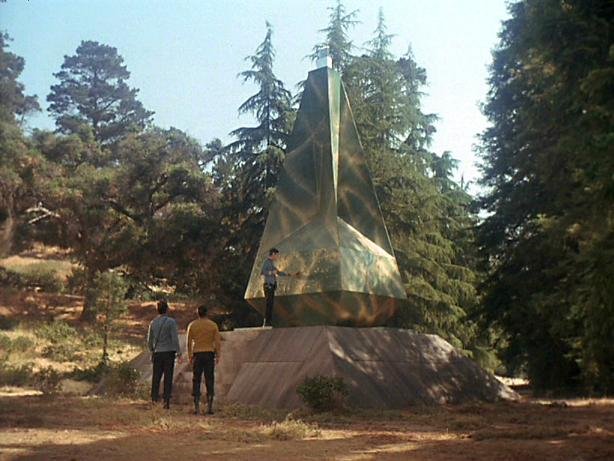Television Review: The Paradise Syndrome (Star Trek, S3X03, 1968)

The Paradise Syndrome (S03E03)
Airdate: October 4th 1968
Written by: Margaret Armen
Directed by: Jud Taylor
Running Time: 50 minutes
The final season of Star Trek: The Original Series (TOS) remains a much-criticised era, marked by dwindling budgets, rushed production schedules, and increasingly desperate creative gambits to salvage a show already teetering on cancellation. Amid this chaotic backdrop, episodes like The Paradise Syndrome emerged as curious experiments—a blend of ambition and ineptitude—that often prioritised novelty over cohesion. Though frequently dismissed as forgettable, The Paradise Syndrome is an intriguing anomaly. Originally overlooked by critics, it quietly established foundational elements of the Star Trek universe’s canon, particularly in its exploration of humanity’s origins and its audacious, if problematic, narrative choices. This episode’s legacy, while flawed, underscores the series’ capacity for unexpected influence even in its twilight hours.
The story unfolds on a seemingly untouched Earth-like planet later named “Amerind” in official Trek lore. Its inhabitants, a tribal society with striking parallels to Indigenous North American cultures, are revealed to be direct descendants of Native Americans—a detail rooted in the Preservers, an ancient alien civilisation introduced here. Captain Kirk’s mission, however, overshadows this anthropological curiosity: he must soon leave for USS Enterprise to deal with asteroid hurtling toward the planet, which threatens to obliterate its population. During his initial exploration, Kirk stumbles upon a mysterious obelisk, triggering an accident that leaves him unconscious and later suffering from amnesia. Stranded, he is discovered by the locals, including the priestess Miramanee (Sabrina Scharf), who reveres him as a prophesied deity and names him “Kirok.” While Spock and McCoy prioritise the asteroid-deflection mission, Kirk gradually embraces his new identity, marrying Miramanee and fathering a child—a development that strains relations with the tribe’s antagonistic medicine chief, Salish (Rudy Solari). The Enterprise, meanwhile, faces technical setbacks, delaying its return, and Kirk’s dual life spirals into tragedy as he must ultimately choose between his Starfleet duties and his newfound family.
The episode distinguishes itself visually through its reliance on location filming at the Franklin Canyon Reservoir, a lush, forested lakeside area that substitutes for the planet’s untamed wilderness. This departure from the season’s overused Vasquez Rocks rock formations injects a serene, almost idyllic quality into the narrative, aligning with the central theme of simplicity versus the pressures of spacefaring life. The setting’s beauty contrasts starkly with the moral complexity of Kirk’s choices, creating a tension that elevates the episode beyond its low-budget constraints. The natural landscape also serves as a metaphor for the planet’s innocence—a stark contrast to the Enterprise’s sterile corridors and the existential threat of the asteroid.
One of The Paradise Syndrome’s boldest departures is its non-linear, month-spanning timeline, a rarity in TOS’s typically compressed, 24-hour narratives. This extended timeframe allows for character development rarely seen in the series, such as Kirk’s gradual assimilation into tribal life and the evolution of his relationship with Miramanee. Kirk’s physical transformation—through changes in hair—is subtly hinted at, visually reinforcing his psychological shift from Starfleet captain to tribal leader. This pacing, however, also exposes the script’s weaknesses, as the prolonged timeline strains credibility and stretches the already thin plot into melodrama.
The episode’s climax is its most polarising element: tragic demise of Kirk’s new family. This melodramatic ending, though not unprecedented in 1960s television, clashes sharply with TOS’s usual blend of cerebral sci-fi and moralising. The abrupt removal of Kirk’s romantic entanglements—conveniently excising potential family drama from future episodes—felt manipulative and emotionally hollow to audiences, contributing to the episode’s poor reputation. Its darkness, while thematically resonant, is undercut by its reliance on soap-opera tropes and a rushed resolution.
Margaret Armen’s script suffers from uneven writing and clunky dialogue. The Native American-inspired culture is handled with problematic stereotyping, reducing complex traditions to simplistic “noble savage” tropes. Miramanee’s character, though well-intentioned, is underdeveloped, her arc dominated by romantic idealism rather than cultural depth. The asteroid-deflection subplot, meanwhile, is underexplored, existing primarily as a plot device to strand Kirk. Director Jud Taylor, however, salvages moments of competence, particularly in the climactic fight scene between Kirk and Salish, which is dynamically staged and physical. Taylor’s use of the reservoir’s natural beauty also enhances the episode’s aesthetic appeal.
William Shatner, however, delivers one of his most enthusiastic performances, embracing the role’s theatrical demands with his signature hamminess. His portrayal of Kirk’s duality—flirtatious charmer and conflicted leader—is both over-the-top and oddly endearing. Shatner’s physicality, from his rugged “Kirok” persona to his final, melodramatic exit, highlights his ability to elevate even flawed material through sheer charisma.
The episode’s most enduring contribution is its introduction of the Preservers, an ancient supercivilisation responsible for seeding humanoid life across the galaxy. This concept not only explains the prevalence of human-like species in Star Trek but also ties Earth’s indigenous populations to a grander cosmic narrative—a notion revisited in later shows. While the Preservers’ role is underutilised here, their inclusion hints at a richer backstory for humanity’s place in the universe, making The Paradise Syndrome a surprisingly influential episode in franchise history. While far from a masterpiece, The Paradise Syndrome is a fascinating relic of TOS’s twilight, a flawed but vital piece of Star Trek’s evolving mythology.
RATING: 5/10 (++)
Blog in Croatian https://draxblog.com
Blog in English https://draxreview.wordpress.com/
InLeo blog https://inleo.io/@drax.leo
LeoDex: https://leodex.io/?ref=drax
InLeo: https://inleo.io/signup?referral=drax.leo
Hiveonboard: https://hiveonboard.com?ref=drax
Rising Star game: https://www.risingstargame.com?referrer=drax
1Inch: https://1inch.exchange/#/r/0x83823d8CCB74F828148258BB4457642124b1328e
BTC donations: 1EWxiMiP6iiG9rger3NuUSd6HByaxQWafG
ETH donations: 0xB305F144323b99e6f8b1d66f5D7DE78B498C32A7
BCH donations: qpvxw0jax79lhmvlgcldkzpqanf03r9cjv8y6gtmk9